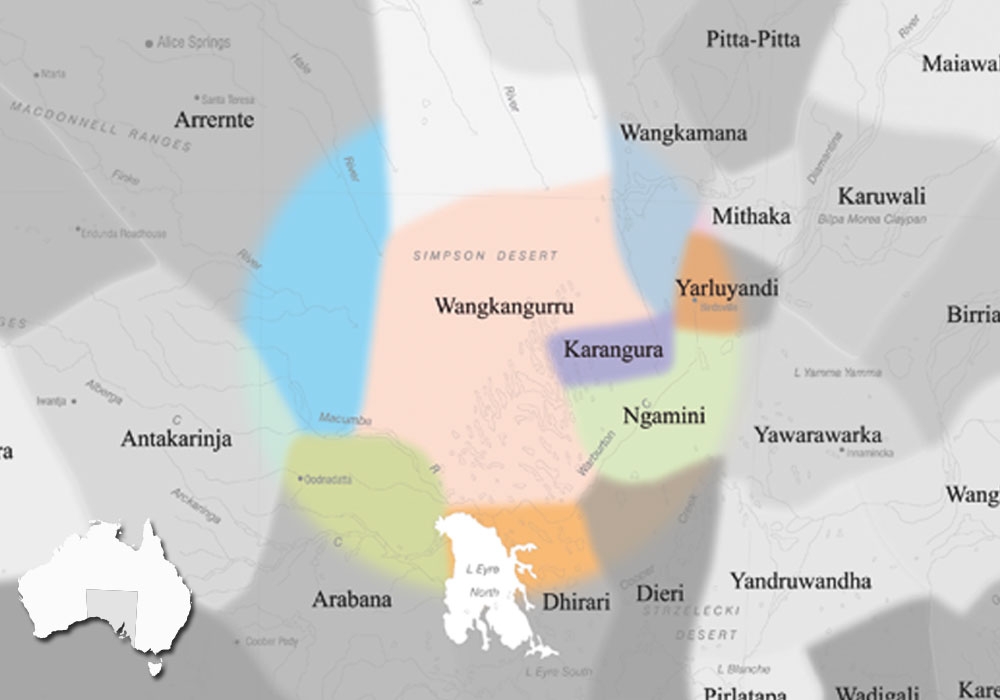The Wangkangurru language is one of the many languages traditionally spoken in the Lake Eyre Basin region, and specifically has deep and long-term associations with the Simpson Desert, the Kallakoopah Creek and the lower Diamantina. Today there are few full speakers of the language and work is underway to revive and maintain Wangkangurru (see below).
Wangkangurru, literally wangka-ngurru ‘the hard and strong language’, has three main dialects.
The dialect known as Mikiri-nganha ‘from the native wells’, also called mungathirri-nganha ‘from the high sandhills’, is the Simpson Desert form of Wangkangurru. The Wangkangurru people gradually left the Simpson Desert until none remained in the area by 1899-1900, but speakers of this dialect persisted in other areas due to strong linguistic and cultural traditions.
The descendants of those Simpson Desert people who settled in the Birdsville area, and who associated closely with people of Ngurlupurlu, Wangkamadla, Yarluyandi and Mithaka descent, speak a variant of the language referred to as Eastern Wangkangurru. This dialect is also known as karla-nganha but is distinct from the Salt Creek variety.
The dialect named Marlu-papu-nganha ‘from the Marlu-papu country’ also referred to as Karla-nganha ‘from the Creek’, Wangkatyaka and Wangkatyari (both names meaning ‘little language’), was originally spoken on the Salt Creek, the Kallakoopah and the lower Diamantina.
There are language lessons available on our Online Language Learning Portal. These were developed with the Crombie family, speakers of Eastern Wangkangurru from the Birdsville region.
(Reference: Hercus, Luise., ‘A Grammar of the Arabana-Wangkangurru Language’, 1994, pp. 7-8, 18-20)
Starting in the 1960s, linguist Luise Hercus worked extensively with Wangkangurru speakers to document the language. She subsequently published ‘A Grammar of the Arabana-Wangkangurru Language’ in 1994 which is available for download here and via Pacific Linguistics out of print archive.
Sisters Joyce and Jean Crombie with the support of the Mobile Language Team have published bilingual storybooks in language, which are available for purchase here.
AIATSIS id : L.27
VARIATIONS
Gongaru, Kanguru (short form of their name), Ongkongura, Ongkonguru, Partama (name given by Kukatja), Unganoora, Wanganguru, Wangganguri, Wangganguru (used by AIATSIS), Wangkanguru (Jangkundjara / Yankunytjatjara pronunciation), Wangkangurru, Wingkungira (Iliaura name), Wonganguru, Wongganguru, Wonggongaru, Wongkaguru, Wongkanguru, Wong-kongaru, Wongkongaru, Wongonooroo, Wongkaoora, Wong-kaooroo Wongkaooroo, Wongkonguru, Wongo-nooroo, Wonka-nguru, Wonkanguru, Wonkangurra, Wonkanjuru, Wonkanooroo, Wonkaoora, Wonkgongaru, Wonkongaru, Wonkongnuru, Wonkonguru.

DISCLAIMER:
The above map is based upon the Horton Indigenous Map of Australia © Aboriginal Studies Press, AIATSIS, and Auslig/Sinclair, Knight, Merz, 1996. The full map is available on the AIATSIS website. The locations of the languages of SA, as stated on the this website are not intended for Land Claim use, and are an approximate guide only. Individual language project locations are based on information from publicly available MILR (ILS) documents.
